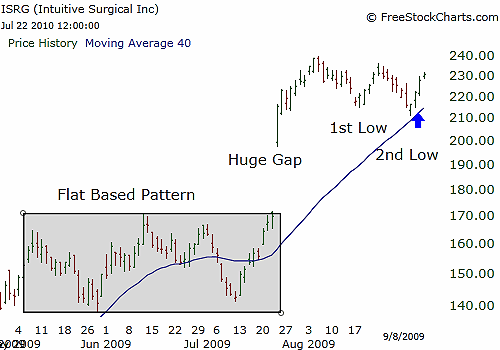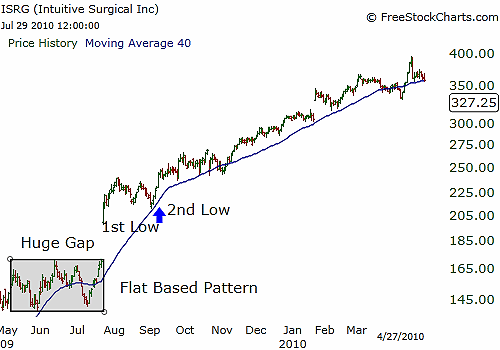
HOT TOPICS LIST
- MACD
- Fibonacci
- RSI
- Gann
- ADXR
- Stochastics
- Volume
- Triangles
- Futures
- Cycles
- Volatility
- ZIGZAG
- MESA
- Retracement
- Aroon
INDICATORS LIST
LIST OF TOPICS
PRINT THIS ARTICLE
by Billy Williams
Chasing an entry whose time has come and gone is a fruitless pursuit. Use an effective backup method for exploiting runaway moves to profit.
Position: N/A
Billy Williams
Billy Williams has been trading the markets for 27 years, specializing in momentum trading with stocks and options.
PRINT THIS ARTICLE
BREAKOUTS
Backup Methods For Runaway Moves
08/03/10 12:31:42 PMby Billy Williams
Chasing an entry whose time has come and gone is a fruitless pursuit. Use an effective backup method for exploiting runaway moves to profit.
Position: N/A
| Contracted price ranges often stagnate between the ebb and flow of lackluster trading until, suddenly, price explodes into a runaway move as price escapes the doldrums of being stuck in a tight price range. These explosive moves tend to make gains very quickly and in a short time, but because the move takes place so fast, you can easily be left behind. This is extremely hard, both mentally and emotionally for a trader who is left on the sidelines after the emergence or resumption of the trend occurs, leading to impulsive trading to try to latch on to the move that is already under way. Impulsive trading occurs the moment a speculator's mental focus shifts from observing the price action of a stock or market to focusing on losing out. This type of focus often becomes a slippery slope, where this subtle change in focus leads to poor decision-making from objective decisions to emotional decisions based on the fear of missing out on a profit-making trade. Basing your trade entries based on a position of fear in your thinking clouds your objectivity and can lead to a hasty trade that often result in a loss. Worse, if a trader loses after trying to chase a runaway move, then begins to follow the logic, he must then make up that loss and begin to chase the fast-moving trend while steadily racking a string of steady losses. This is happening trying to make up for past losses, all the while digging themselves into a deeper financial hole. Since missing a breakout in price action is common and chasing the move can be disastrous, the best alternative is to have a backup method for entering the new trend. That said, using a combination of both a moving average and a price pattern, the 40-day simple moving average (SMA) and support/resistance (S/R), you can have a sound secondary entry method for profitably entering into a strong trend. |

|
| FIGURE 1: ISRG. ISRG formed a flat-based pattern over two months when price exploded and created a huge gap in price. |
| Graphic provided by: FreeStockCharts.com. |
| |
| Intuitive Surgical's (ISRG) price action began consolidating within a price range that formed a flat-based pattern from May 7, 2009, to July 22, 2009, when on July 23, 2009, price exploded out of this pattern on a huge gap move to the upside. This type of breakout would have been very difficult for traders to time an entry into because price didn't trade through the upper range of the flat-based pattern but instead opened above it. It is these types of moves that call for a secondary entry method to exploit the new trend. To filter out potential trade entries, make sure the 40-day moving average is trending upward. A good rule of thumb for bullish trends is to observe whether the 40-day SMA starts at the bottom left-hand screen of your chart and is traveling toward the upper right-hand corner of your chart. Conversely, for bearish moves, the 40-day SMA should start at the upper left-hand corner of your screen and travel toward the lower right-hand corner of your stock chart. Price will then decline to make a significant low like ISRG did on August 18, 2009, and then make a second significant low no less than 10 days later. Eleven days later, ISRG made a second low on September 2, 2009, where you would have entered on the first price bar that closed over the price high of the bar that set the second low on September 2, 2009, which would have given you an entry signal at $221.82. |

|
| FIGURE 2: ISRG. Using a combination of the 40-day SMA and S/R, you would have had a second chance for a profitable entry as price surged upward over the next eight months. |
| Graphic provided by: FreeStockCharts.com. |
| |
| Price then rose from this level to as high as $393.92 on April 15, 2010, before pulling back. This would have yielded a potential profit of $171.10, or 78% return in just eight months. Missed opportunities are as much a part of trading as taking the occasional loss, but having a backup plan is an essential part of professional speculation. The greatest carpenter in the world is useless if he lacks the tools to do the job, and in that sense, striving to be a great trader is a fruitless pursuit if you lack the tools in your own toolbox to accomplish your objectives. Study this method and apply it; then you should start to see its potential. With some work, you will be able to exploit secondary setups when other traders are obsessively trying to catch an entry whose time has come and gone, but you patiently wait for more promising opportunities with this setup. |
Billy Williams has been trading the markets for 27 years, specializing in momentum trading with stocks and options.
| Company: | StockOptionSystem.com |
| E-mail address: | stockoptionsystem.com@gmail.com |
Traders' Resource Links | |
| StockOptionSystem.com has not added any product or service information to TRADERS' RESOURCE. | |
Click here for more information about our publications!
PRINT THIS ARTICLE

|

Request Information From Our Sponsors
- StockCharts.com, Inc.
- Candle Patterns
- Candlestick Charting Explained
- Intermarket Technical Analysis
- John Murphy on Chart Analysis
- John Murphy's Chart Pattern Recognition
- John Murphy's Market Message
- MurphyExplainsMarketAnalysis-Intermarket Analysis
- MurphyExplainsMarketAnalysis-Visual Analysis
- StockCharts.com
- Technical Analysis of the Financial Markets
- The Visual Investor
- VectorVest, Inc.
- Executive Premier Workshop
- One-Day Options Course
- OptionsPro
- Retirement Income Workshop
- Sure-Fire Trading Systems (VectorVest, Inc.)
- Trading as a Business Workshop
- VectorVest 7 EOD
- VectorVest 7 RealTime/IntraDay
- VectorVest AutoTester
- VectorVest Educational Services
- VectorVest OnLine
- VectorVest Options Analyzer
- VectorVest ProGraphics v6.0
- VectorVest ProTrader 7
- VectorVest RealTime Derby Tool
- VectorVest Simulator
- VectorVest Variator
- VectorVest Watchdog
